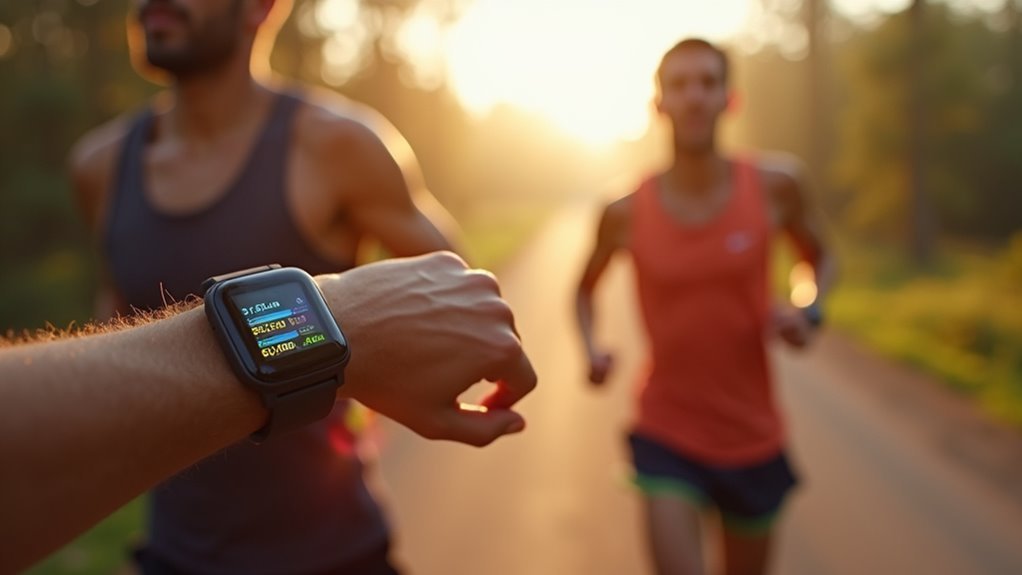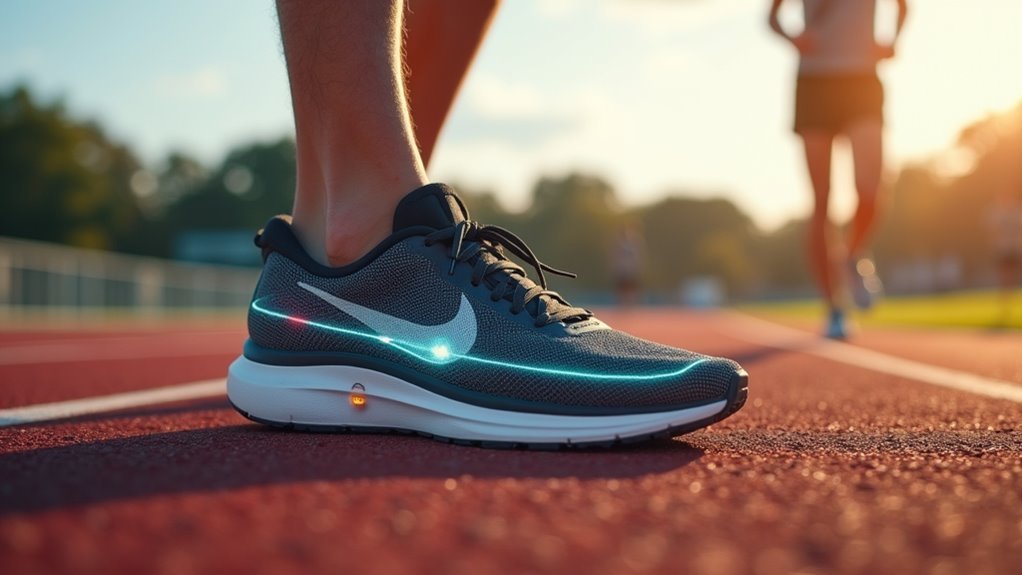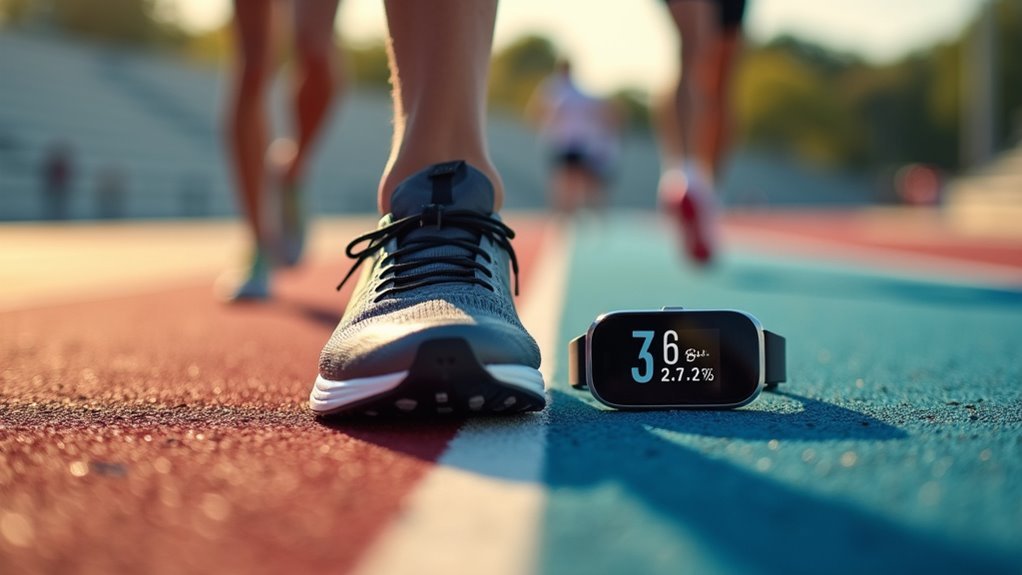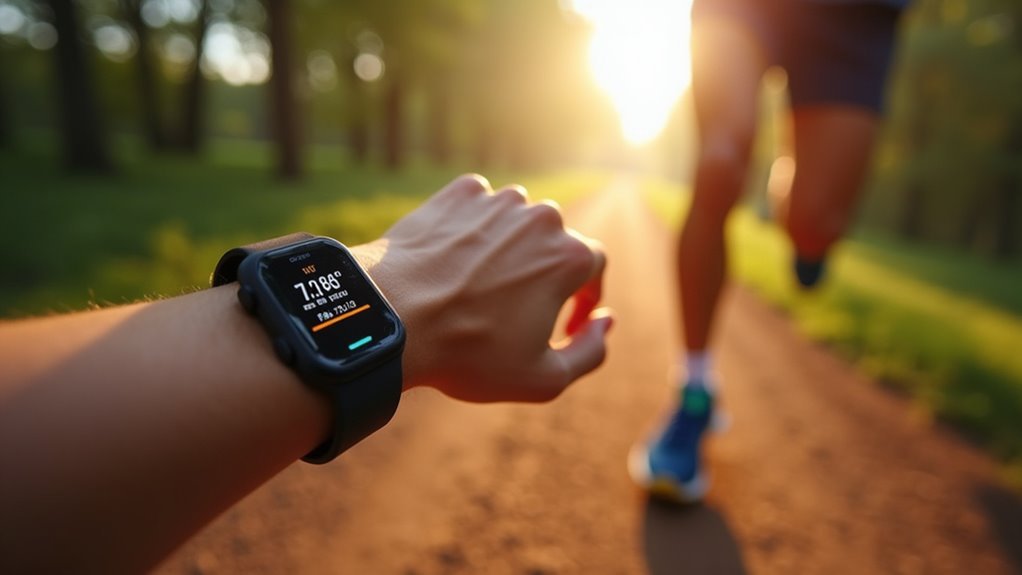You can measure your stride length using running wearables through three main approaches: foot-mounted devices with accelerometers and gyroscopes that provide the highest accuracy, GPS smartwatches that estimate stride length using distance and step count data, or smart insoles with pressure sensors for real-time gait analysis. Foot-mounted sensors offer mean errors around 0.022 meters, while wrist-based devices face accuracy challenges due to indirect measurement. Proper calibration by walking measured distances improves precision across all devices, and understanding these technologies will help you optimize your running performance.
Understanding Stride Length and Its Importance for Running Performance

Precision matters when you’re measuring stride length, the distance your body travels from one footfall to the next on the same side. This measurement considerably influences your running speed and efficiency, making it essential for performance enhancement.
Your stride length affects how much ground you cover with each step, directly impacting your overall pace. However, longer isn’t always better—overstriding can lead to shin splints and knee pain. The key lies in finding your ideal stride length, which depends on your height, leg length, muscle strength, and flexibility.
Proper stride length helps you conserve energy during longer runs and improves your running economy. It works inversely with cadence: shorter strides typically mean higher step frequency, while longer strides result in lower cadence. The naturally chosen stride length is often the most efficient for an individual runner.
Types of Wearable Devices That Measure Stride Length
You’ll find two main categories of wearables that can track your stride length effectively.
Foot-mounted devices like Stryd and RunScribe attach directly to your shoe and use accelerometers and gyroscopes to capture precise movement data. These devices sync seamlessly with running watches or smartphones to provide comprehensive stride analysis.
Wrist-based solutions, including GPS watches with built-in sensors or those paired with running dynamics pods, offer convenient stride tracking from your wrist.
Foot-Mounted Device Options
Two main categories of foot-mounted devices dominate the stride length measurement market: shoe-mounted sensors and sensor-equipped insoles.
These devices directly track your foot movement using accelerometers and gyroscopes, which reduces the drift and errors you’d experience with other measurement methods.
You’ll find that these devices employ advanced algorithms like Kalman filters and machine learning models to enhance accuracy. These systems utilize inertial measurement units (IMUs) that capture tri-axial linear accelerations, angular velocities, and magnetic field strength to provide comprehensive motion tracking data.
They can adapt to your unique gait pattern, whether you’re a typical runner or someone with neurological conditions affecting your stride.
- Thin sensor insoles slipping seamlessly into your favorite running shoes
- Compact pods clipping onto your shoelaces like miniature computers
- Smart insoles lighting up with each footfall during evening runs
- Lightweight sensors barely noticeable as you pound the pavement
Wrist-Based Wearable Solutions
Smartwatches and fitness trackers represent the most popular approach to stride length measurement, leveraging built-in accelerometers and gyroscopes to analyze your arm swing patterns during running.
These wrist-based devices process motion data in real-time, using advanced algorithms to distinguish individual steps and extrapolate stride patterns.
You’ll find machine learning models like artificial neural networks and deep learning approaches increasingly powering these estimations.
Popular brands including Garmin, Apple, and Fitbit offer stride length tracking as standard features. However, accuracy varies considerably—studies show approximately 82% accuracy for younger users and 91% for elderly populations compared to treadmill measurements.
The main limitation stems from wrist placement being less ideal than foot sensors for capturing direct gait data, requiring sophisticated modeling to compensate for this indirect measurement approach. Environmental factors such as terrain, weather conditions, and running surface can significantly influence the measurement accuracy of wrist-based devices.
Foot-Mounted and Shoe-Based Wearable Technologies

While wrist-based devices dominate the consumer market, foot-mounted and shoe-based wearables offer superior precision for measuring stride length and other gait parameters.
These devices use inertial measurement units (IMUs) with tri-axial accelerometers, gyroscopes, and magnetometers to capture detailed movement data at high sampling rates like 128 Hz.
You’ll find foot-mounted devices excel at measuring stride time, speed, and ground contact time with exceptional accuracy.
Shoe-based systems can integrate stereo cameras alongside IMUs, providing extensive gait analysis that rivals lab-based systems.
Many shoe-mounted options cost under $200, making them accessible for home use. Professional-grade systems like RunScribe utilize 500Hz sampling rates to capture every nuance of your running mechanics with exceptional precision.
- Your foot strikes the ground as sensors instantly capture precise impact data
- Gyroscopes detect subtle rotational movements during each stride phase
- Accelerometers measure forward momentum and vertical oscillation patterns
- Real-time algorithms calculate your exact stride length using kinematic data
Smartwatch and Wrist-Worn Device Capabilities
When you’re measuring stride length with your smartwatch, you’ll rely primarily on GPS-based calculations that determine distance traveled and divide it by your step count.
Your wrist-worn device faces inherent accuracy challenges since it’s positioned far from your feet and must estimate ground contact patterns through arm movement detection.
While GPS can provide reasonable stride estimates during outdoor runs, you’ll encounter significant limitations in indoor environments and during activities with irregular movement patterns. For enhanced accuracy, you can compare data between your smartwatch and smartphone, as this cross-device comparison helps validate stride measurements and identify potential discrepancies.
GPS-Based Stride Estimation
GPS technology has revolutionized how modern running wearables calculate stride length, but the accuracy depends heavily on how manufacturers integrate multiple sensors. Your smartwatch combines GPS data with accelerometers and gyroscopes to create detailed stride estimates.
While GPS provides excellent speed data with less than 2% error, it struggles with precise stride measurements due to signal interference and environmental factors. The integration works best when you’re running in open areas where GPS signals remain strong.
However, you’ll notice reduced accuracy on indoor tracks or areas with poor signal reception. Advanced algorithms compensate for these limitations by fusing data from multiple sensors. Some devices use foot pods as an alternative measurement method that can provide more reliable data when GPS signals are compromised.
- GPS satellite signals triangulating your precise ground position every second
- Accelerometer detecting the rhythmic bounce of each footstrike impact
- Gyroscope measuring your arm’s rotational movement patterns during running
- Real-time algorithm calculations processing thousands of data points simultaneously
Accuracy Limitations Overview
Although modern smartwatches pack impressive sensor technology, their stride length measurements face inherent limitations that you’ll encounter during real-world running.
Indoor workouts present the biggest challenge since your device relies solely on wrist motion sensors without GPS assistance, leading to significant inaccuracies. Different manufacturers use varying algorithms, so you’ll notice one brand consistently overestimates while another underestimates your stride length.
Your arm movement patterns directly affect sensor readings—unusual swings or improper device placement reduce accuracy considerably.
Team sports and interval training confuse the algorithms due to frequent intensity changes. Even with proper calibration, you’ll find that distance tracking lags behind step counting accuracy. Many devices lack manual stride adjustment options, preventing users from correcting systematic measurement errors even when they’re aware of consistent discrepancies.
Battery-saving modes compound these issues by reducing data sampling frequency, further compromising stride length precision.
Instrumented Insoles for Precise Gait Analysis

While wrist-worn devices and smartphone apps provide convenient stride tracking, instrumented insoles offer the most precise method for analyzing your gait mechanics.
These smart shoe inserts use pressure sensors and accelerometers to capture real-time data about your foot’s movement patterns, pressure distribution, and timing during each stride cycle.
You’ll receive immediate feedback through wireless connectivity to your smartphone, allowing you to correct your form instantly.
Unlike other wearables that estimate stride length, instrumented insoles directly measure foot contact and movement, providing accuracy comparable to laboratory-grade force plates. Professional-grade systems can deliver ±5% full-scale error rates while maintaining thousands of measurement cycles with minimal recalibration requirements.
- Feel sensors mapping pressure as your heel strikes the pavement
- Watch real-time stride data streaming to your phone display
- Experience instant vibration feedback when your form needs adjustment
- See colorful pressure maps showing your unique footprint pattern
GPS-Based Stride Length Calculation Methods
When you step away from the precision of instrumented insoles, GPS-based tracking presents a more accessible approach to measuring stride length, though it requires careful consideration of its inherent limitations.
Your GPS watch or fitness tracker can’t directly capture heel strikes or foot placement events that define true stride length. Instead, these devices estimate your stride by combining GPS distance data with accelerometer readings and cadence measurements.
You’ll find GPS accuracy suffers in dense forests, urban canyons, or areas with signal interference. Your device compensates by integrating multiple sensors—accelerometers monitor movement patterns while GPS tracks overall distance covered.
Modern running watches use sophisticated algorithms that analyze your movement data over time, learning your unique gait patterns to improve stride length calculations during real-time activities. Some fitness trackers include features to monitor and adjust stride length based on your individual gait characteristics.
Sensor Technologies Behind Stride Length Measurement
Three core sensor technologies power the stride length measurements in your running wearables: accelerometers, gyroscopes, and magnetometers bundled together as Inertial Measurement Units (IMUs). These sensors capture your foot’s movement patterns, measuring acceleration forces and rotational changes with each step you take.
IMUs combine three essential sensors to precisely track your foot’s acceleration, rotation, and movement patterns during every stride you take.
Your device processes this raw sensor data through sophisticated algorithms like Kalman filters and machine learning models. The system integrates acceleration measurements to calculate velocity, then displacement, ultimately determining your stride length. However, sensor placement proves critical – devices positioned near your foot or directly on your shoe capture the most accurate data. Proportional errors in these measurements are generally acceptable for most runners since the relative changes in stride patterns remain meaningful for performance analysis.
- Watch your foot strike the ground as accelerometers detect the sudden deceleration impact
- Feel the forward momentum as gyroscopes measure your leg’s rotational movement through each stride
- Picture the sensor calculating distance as it tracks your foot’s complete arc from takeoff to landing
- Visualize algorithms filtering out noise while your device learns your unique running pattern
Calibrating Your Wearable Device for Accurate Measurements
Even though your wearable device comes equipped with sophisticated sensors and algorithms, it won’t deliver accurate stride length measurements without proper calibration.
Most devices rely on default stride lengths based on height assumptions, which don’t account for your individual biomechanics.
Start calibration by walking a measured 20-30 meter flat course while recording your step count.
Calculate your actual stride length by dividing the total distance by steps taken. Enter this value in your device’s app settings to override the default.
Repeat this process for different activities like running, since stride lengths vary considerably between walking and running.
Perform multiple trials and average the results for better accuracy.
Recalibrate periodically as your fitness level, gait patterns, or footwear changes to maintain measurement precision. Some manufacturers like Garmin allow manual calibration of stride length, while others may have limited customization options.
Factors That Affect Measurement Accuracy and Reliability
Your device’s placement on your body considerably impacts how accurately it measures your stride length.
Where you position your wearable—whether on your wrist, waist, or lower back—directly affects the quality of data it captures during your runs.
Additionally, changes in your running speed and natural gait variations can cause measurement inconsistencies that you’ll need to understand and account for. Your leg length also plays a significant role in determining your natural stride frequency, which affects how your device calculates stride measurements.
Device Placement Impact
Where you position your running wearable directly influences how accurately it captures your stride length data. Different body placements—foot, wrist, or chest—affect measurement precision due to varying sensor configurations and movement patterns.
Your device’s exact positioning matters too; even slight variations can impact data consistency between runs. Sensor sensitivity to placement changes means you’ll need to maintain consistent positioning for reliable measurements.
Environmental constraints like clothing, weather conditions, or terrain can interfere with your device’s ability to capture accurate stride data. You’ll also need time to develop proper wearing habits for consistent data collection.
Modern running watches require extended wear periods to achieve optimal accuracy, as advanced training systems need sufficient data collection time to calibrate their performance algorithms effectively.
- Your smartwatch bouncing loosely on your wrist during hill climbs
- Foot pod sensors shifting inside poorly-fitted shoes on rough trails
- Chest straps sliding during sweaty summer marathons
- GPS watches losing signal under dense forest canopies
Speed and Gait Variables
Beyond placement considerations, your running speed and individual gait characteristics create another layer of complexity for stride length accuracy. As you increase your pace, your stride length typically lengthens, which can challenge some wearables’ measurement algorithms.
Advanced devices with instrumented insoles maintain around 1.76% error across different speeds, while basic sensors may struggle with motion artifacts at higher velocities.
Your unique gait pattern—including step frequency, contact time, and foot strike pattern—directly influences measurement reliability. Since swing time and ground contact time vary between runners, wearables must account for these temporal variables in their calculations.
The tight correlation between these gait components means inconsistencies in one area affect overall stride length accuracy, requiring repeated measurements for reliable results. Running on inclined surfaces further complicates accuracy, as uphill and downhill conditions alter your natural gait mechanics compared to level ground running.
Comparing Different Wearable Devices and Their Performance
When you’re evaluating wearable devices for stride length measurement, you’ll find considerable performance differences based on their underlying technology and algorithmic approaches.
Foot-mounted IMU devices consistently deliver the highest accuracy, with trajectory estimation algorithms achieving mean errors around 0.022 ± 0.157 meters.
Foot-mounted IMU sensors outperform other wearable devices with trajectory algorithms achieving remarkable 0.022-meter mean error rates for stride measurement.
Wrist-worn devices rely on GPS and height-based models, offering convenience but reduced precision compared to dedicated foot sensors.
Performance varies considerably across different conditions:
- Laboratory treadmill tests show controlled accuracy against motion capture systems
- Real-world field studies reveal increased variability due to environmental factors
- Surface types and running speeds affect measurement consistency across devices
- Commercial devices like Garmin combine GPS with internal sensors for improved reliability
Choosing devices with advanced biomechanical models greatly impacts your stride length measurement accuracy. The user interface design of these wearables can significantly affect how effectively you access and interpret your stride data metrics.
Using Stride Length Data to Optimize Your Running Technique
Once you’ve collected stride length data from your wearable device, you can transform those numbers into actionable insights that dramatically improve your running efficiency and reduce injury risk.
Analyze your stride patterns to identify overstriding, which increases knee extension and injury potential. Focus on achieving a cadence of 170-180 steps per minute while making gradual adjustments to your stride length.
Use your data to strengthen core and leg muscles, which support more efficient strides. Incorporate dynamic stretches to enhance hip and ankle mobility – vital factors for maintaining optimal stride mechanics. Pay attention to hamstring tightness and calf flexibility, as these muscle restrictions can significantly impact your ability to adjust stride length effectively.
Monitor how your stride length changes during fatigue and different intensities. Remember, small, consistent adjustments based on your wearable’s feedback yield better results than dramatic changes, helping you enhance running speed without increasing energy expenditure.
Troubleshooting Common Issues With Stride Length Tracking
Even with advanced wearable technology, stride length tracking frequently presents challenges that can frustrate runners seeking accurate performance data.
Despite technological advances, wearable devices still struggle to deliver the precise stride measurements that serious runners demand for training optimization.
You’ll often encounter inconsistent distance readings when your device uses fixed stride lengths rather than adapting to your natural gait variations. Slow walking speeds below 2 mph typically reduce accuracy, while stationary arm movement during runs can cause missed steps.
If you’re experiencing calibration issues, your device may require recalibration using known distances. For the most accurate stride length measurement, walk a 400-meter distance or longer on a track to minimize terrain variations that could affect your readings.
Common troubleshooting scenarios you’ll face include:
- GPS discrepancies – Your watch shows different distances than mapped routes
- Speed-related errors – Inaccurate readings during interval training or tempo changes
- Terrain confusion – Device struggles on hills, trails, or uneven surfaces
- Sensor drift – Gradual accuracy decline requiring periodic recalibration
Frequently Asked Questions
Can Wearable Stride Length Data Help Predict and Prevent Running Injuries?
You can use stride length data from wearables to predict injury risk by analyzing gait patterns and cumulative loading. Real-time feedback helps you adjust your running form, reducing chronic injury risks.
How Much Should I Expect to Spend on Accurate Stride Length Wearables?
You’ll spend $100-$200 for accurate stride length wearables that balance cost and performance. Entry-level devices start at $60, while premium gait analysis models exceed $300 for advanced biomechanical metrics.
Are Stride Length Measurements From Different Wearable Brands Directly Comparable?
You can’t directly compare stride length measurements between different wearable brands because they use varying algorithms, sensor technologies, and calibration methods, causing significant differences in readings even under identical running conditions.
Can I Use Multiple Wearables Simultaneously for More Accurate Stride Measurements?
You can use multiple wearables simultaneously to improve stride measurement accuracy through sensor fusion technology. However, you’ll need specialized software to synchronize data and handle the increased complexity of multi-device integration.
How Long Do Wearable Devices Typically Last Before Needing Replacement?
You’ll typically replace GPS watches after 3-7 years, smartwatches after 2-5 years, and fitness trackers after about 2 years. Battery degradation after 500 charging cycles considerably impacts performance and necessitates replacement.
In Summary
You’ll find that measuring stride length with wearables transforms your running analysis and performance optimization. Whether you’re using foot pods, smartwatches, or instrumented insoles, you’ll get valuable insights into your gait patterns. Don’t expect perfect accuracy from every device, but you’ll notice consistent trends that help you make meaningful adjustments. Focus on the data patterns rather than absolute numbers, and you’ll develop more efficient running techniques that reduce injury risk.





Leave a Reply